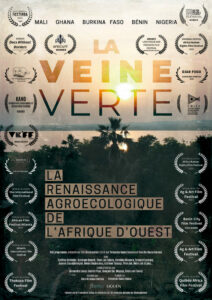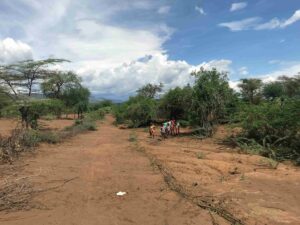
An app for apples: Safeguarding ancient fruit forests in Central Asia
Authors: Anita Makriand Mukta Patil
The apple is ubiquitous in our lives – as much at home in mythologies and alphabet charts as in nutritional needs. But few of us realise that when we bite into that sweet Gala or hear the satisfying crunch of a Golden Delicious, we are reaching back in time and to the mountainous wilderness of Central Asia, where forests of the original apple still stand.
“It’s not apple trees like the trees that we have in Western Europe. It’s ancient apple forms – this is the cradle of the Malus domestica,” says Theo Smits, professor at the Zurich University of Applied Sciences in Wädenswil, Switzerland.
Dubbed Malus sieversii, the ancestor of the domestic apple is a small, cherry-sized fruit which can taste anywhere between bitter, astringent and sweet.
Smits is working with local partners to prevent the spread of an invasive disease that threatens these ancient varieties in the region’s forests and orchards.
Fire blight, caused by the bacterium Erwinia amylovora, is devastating for pome fruits like apples and pears. Once struck by the disease, a healthy tree can turn completely black and die within a season.
The project team is racing to track where it’s spreading, in a bid to stop it. “The main problem in Kyrgyzstan and Kazakhstan is that currently there is no tool which they can use to monitor [the spread of] fire blight,” says Smits.
“There is no tool to monitor the spread of fire blight”
Theo Smits, Zurich University of Applied Sciences
At risk from an alien invader
It is the consumer’s desire for a certain kind of apple that has, in some ways, been its undoing. Modern domestic apples are but a few varieties picked from the fruit’s vast gene pool. This makes apple trees more susceptible to disease.
Fire blight was first found in North America in the 1780s, and imported to Western Europe in the 1950s. Smits says it likely travelled to the original pome forests of Central Asia when infected trees were brought from Europe to Kazakstan and Kyrgyzstan, for planting in orchards.
The first cases of the blight were picked up in Kazakh and Kyrgyz orchards in 2008. Smits says that it now threatens the whole forest ecosystem in the area, because these apple trees have never been exposed to fire blight in the course of their centuries-long life history.
Safeguarding the trees that carry the original apple matters for the region and beyond. Losing them means draining the gene pool of diversity that could hold the key to preserving apple varieties for the future. In some parts of Kazakhstan and Kyrgyzstan, it also means losing a vital source of income. The region’s pome trees are an important part of the forest ecosystem that local people, plants and animals rely on.
“If you live in Kyrgyzstan, you will see that people either do horticulture, or they breed livestock,” explains Ormon Sultangaziev, an ecologist with the NGO Flora and Fauna International (FFI) based in the country, and a collaborator on the project. But in many areas, land may be limited and livestock feed beyond their means. A family will then rely on growing apples, pears or other fruits in their orchards. They might sell their harvest in neighbouring countries – Uzbekistan, Kazakhstan, maybe Russia.
Sometimes, that’s their only livelihood. But many locals are oblivious to the scale of the fire blight problem, says Sultangaziev.
Citizen-led mapping
To keep these trees healthy, researchers need a wealth of data to answer key questions. What route did the Erwinia amylovora take to reach this area? How is it spreading within this ecosystem? How can local scientists and citizens recognise the pathogen and test trees for it? And what measures can people take to stop it from spreading through the forest, neighbouring orchards and gardens?

Picture 1: Wilted branches with dead leaves in a Pyrus communis cv. “Talgarskaya” tree. Credit: T. Doolotkeldieva, Kyrgyz-Turkish Manas University, Bishkek, Kyrgyzstan
Research to answer these questions, which began in 2018, is supported by the r4d programme, a joint initiative by the Swiss Agency for Development and Cooperation and the Swiss National Science Foundation. The aim is to come up with locally adapted measures to control the blight and help to preserve the germplasm of healthy fruit-tree species.
Now, an additional grant is helping the research team build an app that maps instances of blight and informs local people about the disease. According to Smits, a good monitoring tool is essential in order to picture how the blight is spreading in both Kazakhstan and Kyrgyzstan. “This is one of the most important parts to find where the disease is heading,” he says
The fire blight app is modelled on technology already being used in Switzerland to gather data about risk from ticks. Its interface shows updated maps of user-uploaded tick bites. The fire blight app will also be designed to educate local people in both countries about what the disease could look like – the signs to watch out for – and then upload the locations of afflicted trees on a map.
Smits believes citizen-led mapping will make it easier to keep tabs on spread. “Both the layman and the foresters can enter data … so if they detect fire blight, one can see it immediately on an interactive map for that day,” he explains, adding that through this approach, field monitoring can get more specific and more accurate.

Picture 2: Presence of fire blight at different locations in the Jalal-Abad region, and within the Arslonbob natural forest and geographical location of individuals of critically endangered apple and pear tree species. Credit: S. Carnal and F. Rezzonico, Zurich University of Applied Sciences Wädenswil, Switzerland
That could make a tangible difference to people who live in the area. Getting a clear picture of the risk for fire blight around the endangered pome species in these forests will allow them to protect their own orchards through measures like buffers or bio-control agents.
The information could also help discover local apple varieties that do show some tolerance to fire blight, and could be used for breeding programmes.
Laying the groundwork
Almaty, Kazakhstan’s former capital, was once called Alma-Ata, which translates to ‘Father of Apples.’ In April-May, the flanks of mountains in the region are covered with the pale, white and pink apple blossoms.
That’s also when fire blight season begins. Smits hopes a prototype will be ready to test by the end of 2021.
Meanwhile, the project team is laying the groundwork: persuading locals to use it. This is where local partners step in. Smits is collaborating closely with FFI, the Plant Protection Department at the Kyrgyz–Turkish Manas University, and the Kazakh Institute of Horticulture and Viticulture.
Sultangaziev is coordinating a series of activities designed to raise awareness: a brochure, video material, workshops and seminars – all designed to explain the science behind the spread of fire blight in simple language. “We can tell them whom to go [talk to], and whom to ask if they identify fire blight in their gardens.”

Picture 3: Fire blight training course in Kyzyl-Unkur, Kyrgyzstan. Credit: M. Cherniavskaia and J. Samanchina, Fauna and Flora International, Bishkek, Kyrgyzstan
The success of mapping where fire blight is spreading hinges in large part on how regularly the app is used, and the team knows this may take time. Sultangaziev believes that community outreach activities will be crucial until people become comfortable with the new technology.
Many people in the region do not own a smartphone, he explains. Some may not have Internet connectivity. Others may simply not be used to sharing information through a digital platform. Making the most of the app’s potential will depend on how easily people can access it, and whether it can work in local languages. Sultangaziev and colleagues are looking into making the interface accessible in Kazakh, Kyrgyz, Russian, and Tajik.
Assurance of data privacy also matters. For example, the team will have to convince users that their inputs will be anonymous, despite being geotagged. FFI is already known and trusted by local people for its work in the Kyrgyz forests, and the hope is that this will ease any concerns about adopting the app.
“We need to inform people at the beginning“
Ormon Sultangaziev, Flora and Fauna International
Once affected areas are mapped, local university researchers will step in to test the trees. This is to confirm whether they’re under attack by the disease, or for research into the pathogen and how it behaves. The test looks and works like a pregnancy stick: two lines for a positive result show up when it picks up a certain concentration of proteins attached to the pathogen.
Smits and his Swiss collaborators will also perform complete genome analysis of the pathogens isolated through testing, in a bid to reconstruct the path that Erwinia amylovora took to spread across this Central Asia region – where it originated, and how it moved. Meanwhile, Tinatin Doolotkeldieva, a plant pathologist based in Kyrgyzstan and one of the first plant pathologists to discover fire blight in the country, continues to work on ways to fight it.
Orchestrating an effective defence against fire blight in these mountains will need all parts of the project working in tandem. And getting locals on board is key. “We need to inform people at the beginning,” says Sultangaziev. “Their help, their contribution, is vital.”
Related Posts
The Green Vein: Agroecology Rising in West Africa
WOMEN EMPOWERED: Vital Work Made Visible
Sources
Transformation Accelerating Initiative:
Preserving Central Asian fruit tree forest ecosystems
Credit title picture:
J. Samanchina, Fauna and Flora International, Bishkek, Kyrgyzstana
About the authors:
Anita Makri is a freelance editor/writer/producer based in London, UK. Mukta Patil is a freelance journalist working in the US and India. She writes about energy, environment, and climate change.
Produced by:
Anita Makri and Mukta Patil





